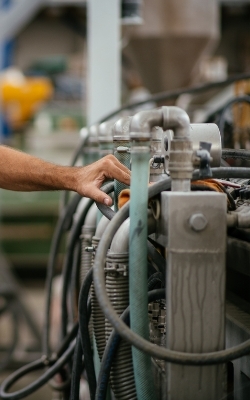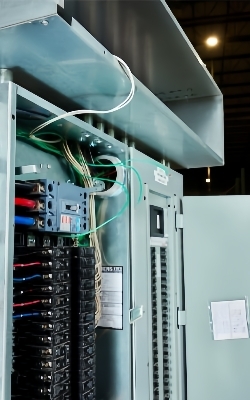The operating frequency range of the electrical rotation meter is 15Hz~400Hz, and the three phase lines and the phase sequence rotation direction are clearly indicated through the LCD display. Double insulation protection design ensures the safety of users and instruments.

LCD Large Screen Display
- Clear LCD large screen display, convenient for users to read test data.
- With CAT III 600V safety rating, double insulation protection design.
- No battery or external power supply is required, it is powered directly by the circuit under test, greatly saving the cost and working time.

Clear Marking
- The instruction form is attached below the LCD, and the bottom marking is clear, which is convenient and quick to use for reference.
- The overall design is compact and can be easily put into the tool bag for storage.
Applications
The application scenarios of phase sequence meters are very wide, covering multiple fields from basic power system debugging to complex industrial control systems. It has a wide range of applications in multiple fields. It not only ensures the correct operation of the equipment but also improves the safety and efficiency of the system. With the continuous advancement of technology, the functions of the phase sequence meter will be more diversified in the future, and its application in various fields will become more popular and important.

Equipment Maintenance

Factory Area

Teaching Experience

Electrician Field
| Model | SISCO-PRM-UT261A |
| AC Voltage | 40~690V |
| Test Frequency | 15~400Hz |
| Working Current | <3mA |
| Power Supply | Power supply in the grid |
| Dimensions | 70mm×75mm×30mm |
| Weight | 180g |
Packaging List

- Host
- Alligator Clip
- Instruction Manual
- Test Lead
- Cloth Bag
Q1: What factors can affect the phase rotation meter?
A1: The measurement accuracy and stability of the phase sequence meter may be affected by many factors. First, an unstable power supply or voltage that is too high or too low may cause deviations in the measurement results of the phase sequence meter. Secondly, circuit board aging, component damage, etc. may affect the normal operation of the phase sequence meter. In addition, sensor failure or damage will not be able to correctly detect the phase sequence information of the power supply. Of course, human errors in equipment settings or operating methods can also lead to measurement errors.
Q2: How does a phase rotation meter work?
A2: The working principle of the phase sequence meter is based on the detection and processing of three-phase voltage or current signals. It determines whether the phase sequence is correct by comparing the phase difference between the three-phase voltages. Common phase sequence detection algorithms include those based on zero-sequence detection and those based on positive and negative sequence components. When the phase sequence is correct, these algorithms will output corresponding signals to indicate that the phase sequence is correct; otherwise, they will indicate that the phase sequence is wrong.
Q3: What technical parameters should be paid attention to?
A3: The technical parameters of the phase sequence meter include but are not limited to input voltage range, power supply voltage, meter size, weight, ambient temperature, humidity, etc. These parameters are crucial for evaluating the performance and application scope of the phase sequence meter. In addition, the phase sequence meter must also have a certain insulation strength and anti-interference ability to adapt to different use environments and ensure the safety of operators.
Tips: Safety precautions when using a phase sequencer
As an important electrical detection tool, the phase rotation tester must not only master the correct operation method when using it but also strictly abide by the relevant safety precautions to ensure the smooth progress of the detection work and personal safety.
Safe Operation
When using the motor rotation tester, appropriate safety protection measures must be taken. Before the operation, make sure that the power supply is disconnected, and set up warning signs in the operation area to prevent others from entering by mistake.
Avoid Electric Shock
During the use of the phase sequence meter, a higher voltage will pass through, so be sure to cut off the power supply before opening the case to prevent electric shock.
Environmental Conditions
Avoid using the phase indicator with an open phase checker in a humid or high-temperature environment, and do not let the instrument come into contact with water or other corrosive liquids. In areas or seasons with humid climates, pay special attention to moisture prevention.
Operation Specifications
When using the phase sequencer, it should be operated strictly in accordance with the instructions provided by the manufacturer, and the internal circuit of the instrument shall not be changed at will. During operation, the human body shall not touch the instrument and the instrument line, and keep a safe distance.
Thank you for buying industrial test and measurement equipment on SISCO.com, all products sold by SISCO and the partner cover a 12 months warranty, effective from the date of receiving the products.
What is covered?
SISCO is responsible for providing free spare parts, and free technical support to assist the customer to repair the defective products until the problem is solved.
What is not covered?
- Product purchased from anyone other than a SISCO store or a SISCO authorized reseller.
- Expendable parts.
- Routine cleaning or normal cosmetic and mechanical wear.
- Damage from misuse, abuse or neglect.
- Damage from use of parts other than SISCO approved.
- Damage from use outside the product’s usage or storage parameters.
- Damage from use of parts not sold by SISCO.
- Damage from modification or incorporation into other products.
- Damage from repair or replacement of warranted parts by a service provider other than a SISCO authorized service provider.
- Damage caused by the application environment not meeting the product usage requirements and the failure to perform preventive maintenance.

